介词oninat 的用法
- 格式:doc
- 大小:18.50 KB
- 文档页数:3
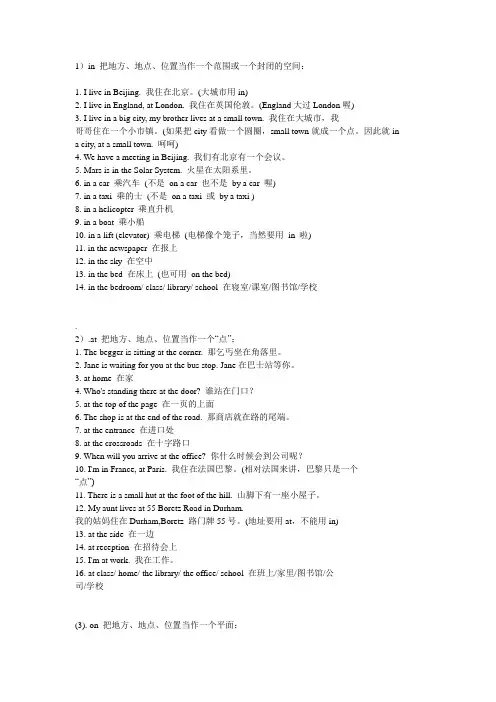
1)in 把地方、地点、位置当作一个范围或一个封闭的空间:1. I live in Beijing. 我住在北京。
(大城市用in)2. I live in England, at London. 我住在英国伦敦。
(England大过London喔)3. I live in a big city, my brother lives at a small town. 我住在大城市,我哥哥住在一个小市镇。
(如果把city看做一个圆圈,small town就成一个点。
因此就ina city, at a small town. 呵呵)4. We have a meeting in Beijing. 我们有北京有一个会议。
5. Mars is in the Solar System. 火星在太阳系里。
6. in a car 乘汽车(不是on a car 也不是by a car 喔)7. in a taxi 乘的士(不是on a taxi 或by a taxi )8. in a helicopter 乘直升机9. in a boat 乘小船10. in a lift (elevator) 乘电梯(电梯像个笼子,当然要用in 啦)11. in the newspaper 在报上12. in the sky 在空中13. in the bed 在床上(也可用on the bed)14. in the bedroom/ class/ library/ school 在寝室/课室/图书馆/学校.2).at 把地方、地点、位置当作一个“点”:1. The begger is sitting at the corner. 那乞丐坐在角落里。
2. Jane is waiting for you at the bus stop. Jane在巴士站等你。
3. at home 在家4. Who's standing there at the door? 谁站在门口?5. at the top of the page 在一页的上面6. The shop is at the end of the road. 那商店就在路的尾端。
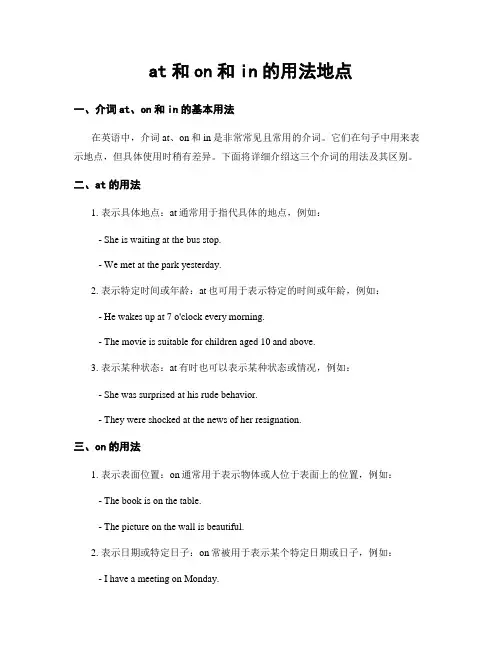
at和on和in的用法地点一、介词at、on和in的基本用法在英语中,介词at、on和in是非常常见且常用的介词。
它们在句子中用来表示地点,但具体使用时稍有差异。
下面将详细介绍这三个介词的用法及其区别。
二、at的用法1. 表示具体地点:at通常用于指代具体的地点,例如:- She is waiting at the bus stop.- We met at the park yesterday.2. 表示特定时间或年龄:at也可用于表示特定的时间或年龄,例如:- He wakes up at 7 o'clock every morning.- The movie is suitable for children aged 10 and above.3. 表示某种状态:at有时也可以表示某种状态或情况,例如:- She was surprised at his rude behavior.- They were shocked at the news of her resignation.三、on的用法1. 表示表面位置:on通常用于表示物体或人位于表面上的位置,例如:- The book is on the table.- The picture on the wall is beautiful.2. 表示日期或特定日子:on常被用于表示某个特定日期或日子,例如:- I have a meeting on Monday.- Our anniversary falls on June 30th this year.3. 表示上车/登机:on可以表示上车或登机等行为,例如:- Please get on the bus.- The passengers are boarding on the plane.四、in的用法1. 表示三维空间内的位置:in通常用于表示物体或人位于三维空间内的位置,例如:- The books are in the bookshelf.- She is sitting in the car.2. 表示地区或国家:in可以表示特定的地区或国家,例如:- He lives in New York City.- They spent their summer vacation in Italy.3. 表示具体房间/建筑内部:in也可用于表示物体或人位处于具体房间或建筑内部,例如:- The children are playing in the living room.- He is waiting for you in his office.五、在一些固定短语中的使用除了基本的用法之外,at、on和in还在某些固定短语中使用,需要单独记忆。
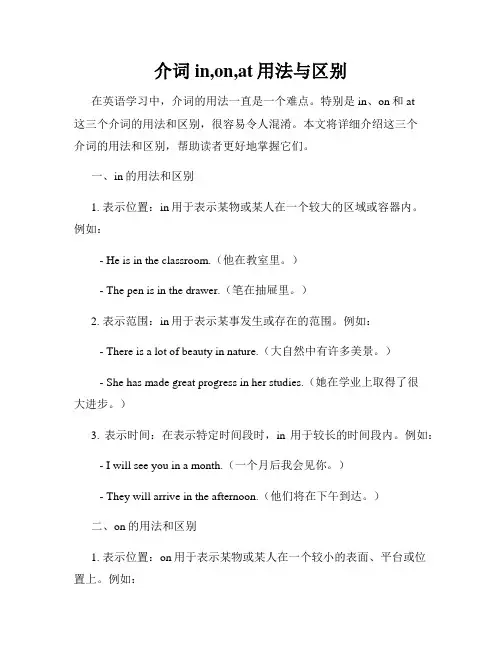
介词in,on,at用法与区别在英语学习中,介词的用法一直是一个难点。
特别是in、on和at这三个介词的用法和区别,很容易令人混淆。
本文将详细介绍这三个介词的用法和区别,帮助读者更好地掌握它们。
一、in的用法和区别1. 表示位置:in用于表示某物或某人在一个较大的区域或容器内。
例如:- He is in the classroom.(他在教室里。
)- The pen is in the drawer.(笔在抽屉里。
)2. 表示范围:in用于表示某事发生或存在的范围。
例如:- There is a lot of beauty in nature.(大自然中有许多美景。
)- She has made great progress in her studies.(她在学业上取得了很大进步。
)3. 表示时间:在表示特定时间段时,in用于较长的时间段内。
例如:- I will see you in a month.(一个月后我会见你。
)- They will arrive in the afternoon.(他们将在下午到达。
)二、on的用法和区别1. 表示位置:on用于表示某物或某人在一个较小的表面、平台或位置上。
例如:- The book is on the table.(书在桌子上。
)- He is sitting on the chair.(他正坐在椅子上。
)2. 表示日期和天:on用于具体的日期或星期几,以及天。
例如:- My birthday is on May 10th.(我的生日是在5月10日。
)- We have a meeting on Monday.(我们星期一开会。
)- I usually go jogging on sunny days.(我通常在晴天慢跑。
)3. 表示通讯媒介:on用于表示使用某种通讯媒介。
例如:- I heard the news on the radio.(我通过收音机听到了这个消息。
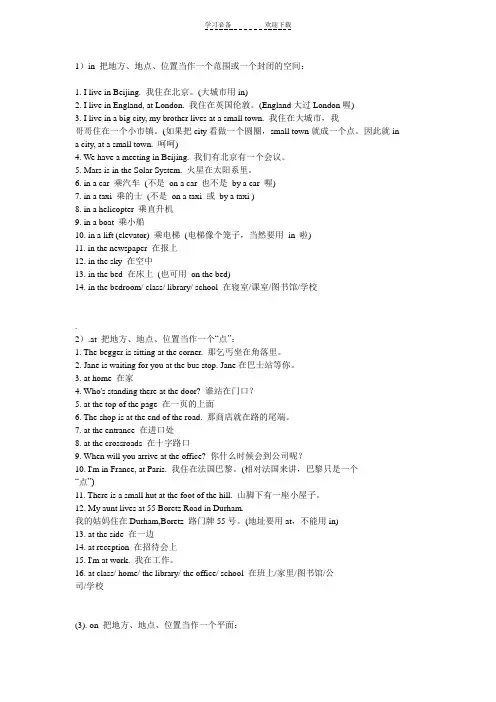
1)in 把地方、地点、位置当作一个范围或一个封闭的空间:1. I live in Beijing. 我住在北京。
(大城市用in)2. I live in England, at London. 我住在英国伦敦。
(England大过London喔)3. I live in a big city, my brother lives at a small town. 我住在大城市,我哥哥住在一个小市镇。
(如果把city看做一个圆圈,small town就成一个点。
因此就ina city, at a small town. 呵呵)4. We have a meeting in Beijing. 我们有北京有一个会议。
5. Mars is in the Solar System. 火星在太阳系里。
6. in a car 乘汽车(不是on a car 也不是by a car 喔)7. in a taxi 乘的士(不是on a taxi 或by a taxi )8. in a helicopter 乘直升机9. in a boat 乘小船10. in a lift (elevator) 乘电梯(电梯像个笼子,当然要用in 啦)11. in the newspaper 在报上12. in the sky 在空中13. in the bed 在床上(也可用on the bed)14. in the bedroom/ class/ library/ school 在寝室/课室/图书馆/学校.2).at 把地方、地点、位置当作一个“点”:1. The begger is sitting at the corner. 那乞丐坐在角落里。
2. Jane is waiting for you at the bus stop. Jane在巴士站等你。
3. at home 在家4. Who's standing there at the door? 谁站在门口?5. at the top of the page 在一页的上面6. The shop is at the end of the road. 那商店就在路的尾端。
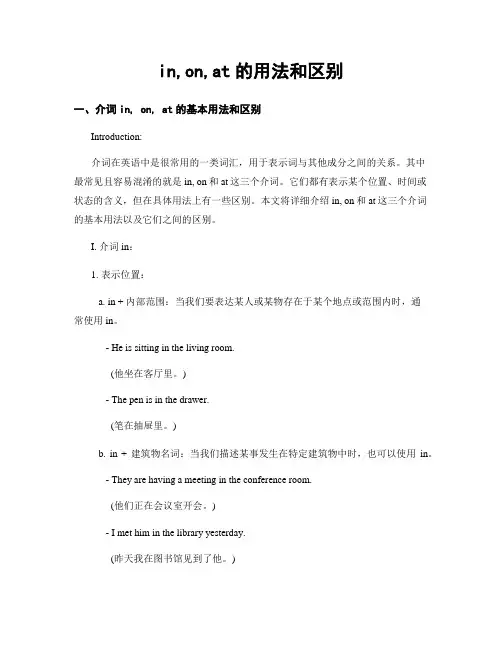
in,on,at的用法和区别一、介词in, on, at的基本用法和区别Introduction:介词在英语中是很常用的一类词汇,用于表示词与其他成分之间的关系。
其中最常见且容易混淆的就是in, on和at这三个介词。
它们都有表示某个位置、时间或状态的含义,但在具体用法上有一些区别。
本文将详细介绍in, on和at这三个介词的基本用法以及它们之间的区别。
I. 介词in:1. 表示位置:a. in + 内部范围:当我们要表达某人或某物存在于某个地点或范围内时,通常使用in。
- He is sitting in the living room.(他坐在客厅里。
)- The pen is in the drawer.(笔在抽屉里。
)b. in + 建筑物名词:当我们描述某事发生在特定建筑物中时,也可以使用in。
- They are having a meeting in the conference room.(他们正在会议室开会。
)- I met him in the library yesterday.(昨天我在图书馆见到了他。
)2. 表示时间:a. in + 年份/季节/月份/早上、下午等概括性时间段:使用in来表示较为宽泛的时间范围。
- She was born in 1990.(她出生于1990年。
)- I love to go swimming in summer.(我喜欢在夏天去游泳。
)b. in + 具体日期:当我们要指定一个具体的日期时,同样使用in。
- We have an appointment in two weeks.(我们有个在两周后的约会。
)- The seminar will be held in October.(研讨会将在10月份举行。
)3. 表示状态:a. 表示事物所处的状态或情况。
- She is in a good mood today.(她今天心情很好。
)- The project is currently in development.(项目目前还在开发中。
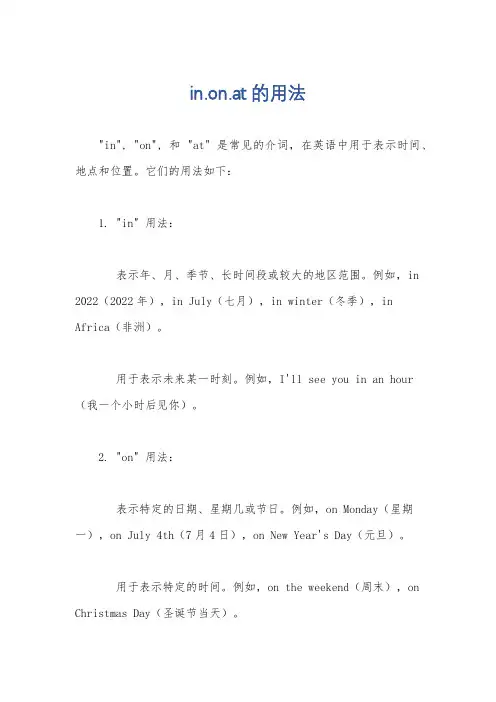
in.on.at的用法
"in", "on", 和 "at" 是常见的介词,在英语中用于表示时间、地点和位置。
它们的用法如下:
1. "in" 用法:
表示年、月、季节、长时间段或较大的地区范围。
例如,in 2022(2022年),in July(七月),in winter(冬季),in Africa(非洲)。
用于表示未来某一时刻。
例如,I'll see you in an hour (我一个小时后见你)。
2. "on" 用法:
表示特定的日期、星期几或节日。
例如,on Monday(星期一),on July 4th(7月4日),on New Year's Day(元旦)。
用于表示特定的时间。
例如,on the weekend(周末),on Christmas Day(圣诞节当天)。
3. "at" 用法:
表示具体的时间。
例如,at 3 o'clock(3点钟),at noon(中午),at midnight(午夜)。
用于表示特定的地点或位置。
例如,at the bus stop(在公交车站),at the door(在门口)。
需要注意的是,这些介词的使用有时候是固定搭配,需要根据具体语境来判断。
希望这些解释能帮助你更好地理解它们的用法。
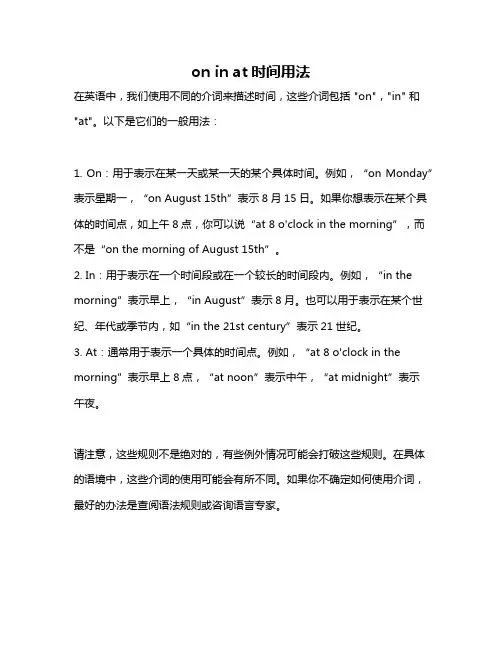
on in at时间用法
在英语中,我们使用不同的介词来描述时间,这些介词包括 "on","in" 和"at"。
以下是它们的一般用法:
1. On:用于表示在某一天或某一天的某个具体时间。
例如,“on Monday”表示星期一,“on August 15th”表示8月15日。
如果你想表示在某个具体的时间点,如上午8点,你可以说“at 8 o'clock in the morning”,而不是“on the morning of August 15th”。
2. In:用于表示在一个时间段或在一个较长的时间段内。
例如,“in the morning”表示早上,“in August”表示8月。
也可以用于表示在某个世纪、年代或季节内,如“in the 21st century”表示21世纪。
3. At:通常用于表示一个具体的时间点。
例如,“at 8 o'clock in the morning”表示早上8点,“at noon”表示中午,“at midnight”表示
午夜。
请注意,这些规则不是绝对的,有些例外情况可能会打破这些规则。
在具体的语境中,这些介词的使用可能会有所不同。
如果你不确定如何使用介词,最好的办法是查阅语法规则或咨询语言专家。
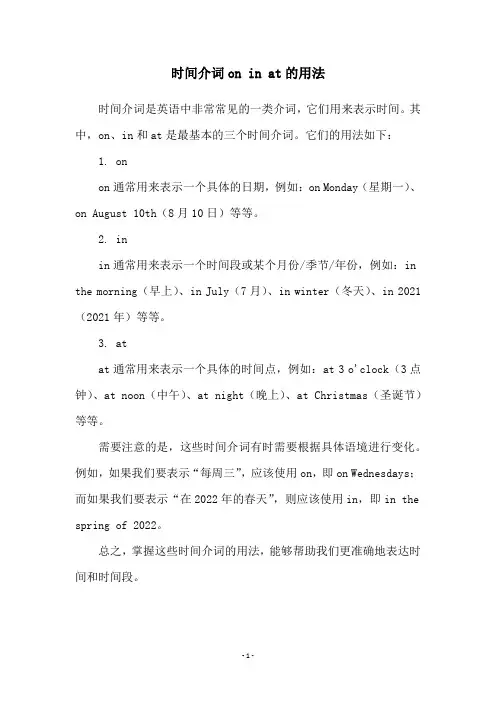
时间介词on in at的用法
时间介词是英语中非常常见的一类介词,它们用来表示时间。
其中,on、in和at是最基本的三个时间介词。
它们的用法如下:
1. on
on通常用来表示一个具体的日期,例如:on Monday(星期一)、on August 10th(8月10日)等等。
2. in
in通常用来表示一个时间段或某个月份/季节/年份,例如:in the morning(早上)、in July(7月)、in winter(冬天)、in 2021(2021年)等等。
3. at
at通常用来表示一个具体的时间点,例如:at 3 o'clock(3点钟)、at noon(中午)、at night(晚上)、at Christmas(圣诞节)等等。
需要注意的是,这些时间介词有时需要根据具体语境进行变化。
例如,如果我们要表示“每周三”,应该使用on,即on Wednesdays;而如果我们要表示“在2022年的春天”,则应该使用in,即in the spring of 2022。
总之,掌握这些时间介词的用法,能够帮助我们更准确地表达时间和时间段。
- 1 -。
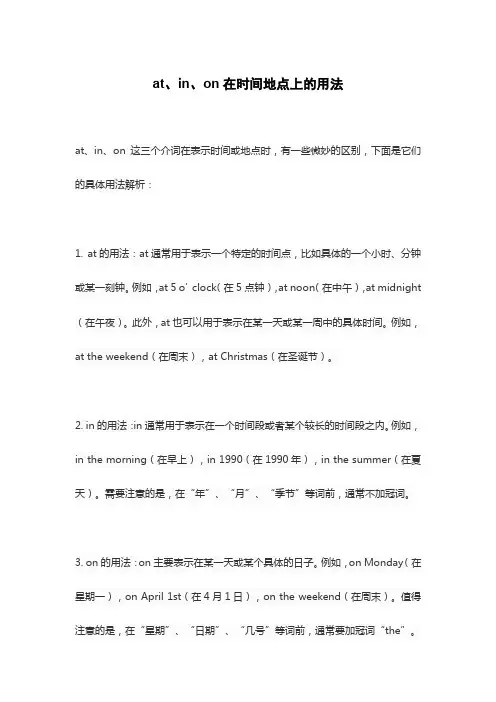
at、in、on在时间地点上的用法at、in、on这三个介词在表示时间或地点时,有一些微妙的区别,下面是它们的具体用法解析:1. at的用法:at通常用于表示一个特定的时间点,比如具体的一个小时、分钟或某一刻钟。
例如,at 5 o’clock(在5点钟),at noon(在中午),at midnight (在午夜)。
此外,at也可以用于表示在某一天或某一周中的具体时间。
例如,at the weekend(在周末),at Christmas(在圣诞节)。
2. in的用法:in通常用于表示在一个时间段或者某个较长的时间段之内。
例如,in the morning(在早上),in 1990(在1990年),in the summer(在夏天)。
需要注意的是,在“年”、“月”、“季节”等词前,通常不加冠词。
3. on的用法:on主要表示在某一天或某个具体的日子。
例如,on Monday(在星期一),on April 1st(在4月1日),on the weekend(在周末)。
值得注意的是,在“星期”、“日期”、“几号”等词前,通常要加冠词“the”。
关于地点方面,这三个介词的区别主要如下:1. at表示在某一点,或者在小的、具体的范围内。
例如,at the bus stop(在公交车站),at the crossroads(在十字路口)。
2. in表示在一个较大的、封闭的空间或者范围之内。
例如,in the classroom (在教室里),in the office building(在办公楼里)。
3. on表示在某个物体的表面或者上方。
例如,on the table(在桌子上),on the floor(在地上)。
以上是at、in、on三个介词的基本用法解析,它们的具体用法可能会因语境的不同而有所变化。
在使用时,要根据具体的语境选择合适的介词。
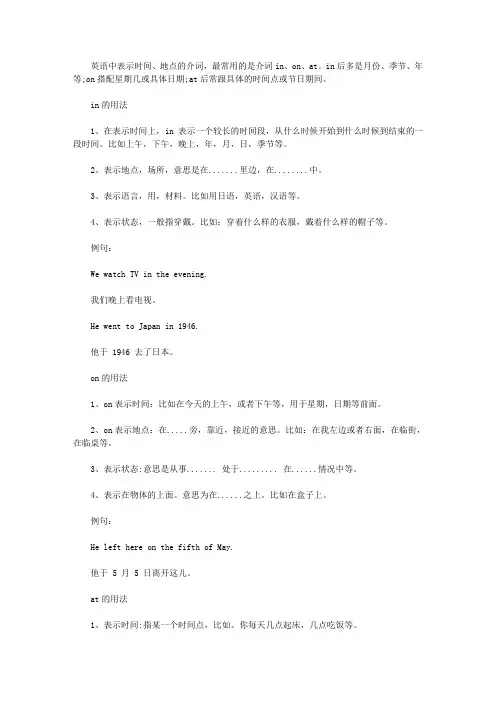
英语中表示时间、地点的介词,最常用的是介词in、on、at。
in后多是月份、季节、年等;on搭配星期几或具体日期;at后常跟具体的时间点或节日期间。
in的用法1、在表示时间上,in表示一个较长的时间段,从什么时候开始到什么时候到结束的一段时间。
比如上午,下午,晚上,年,月,日,季节等。
2、表示地点,场所,意思是在.......里边,在........中。
3、表示语言,用,材料。
比如用日语,英语,汉语等。
4、表示状态,一般指穿戴。
比如:穿着什么样的衣服,戴着什么样的帽子等。
例句:We watch TV in the evening.我们晚上看电视。
He went to Japan in 1946.他于 1946 去了日本。
on的用法1、on表示时间:比如在今天的上午,或者下午等,用于星期,日期等前面。
2、on表示地点:在.....旁,靠近,接近的意思。
比如:在我左边或者右面,在临街,在临桌等。
3、表示状态:意思是从事....... 处于......... 在......情况中等。
4、表示在物体的上面。
意思为在......之上。
比如在盒子上。
例句:He left here on the fifth of May.他于 5 月 5 日离开这儿。
at的用法1、表示时间:指某一个时间点,比如。
你每天几点起床,几点吃饭等。
2、在某个特定的时间,时机,时候,季节等用at.3、在........岁。
也用at.比如,在我8岁的时候,10岁的时候等4、在.......方面。
用at。
比如。
在工作方面,生活方面等。
例句:I get up at six in the morning.我早上六点钟起床。
He got married at the age of 25.他 25 岁结婚。
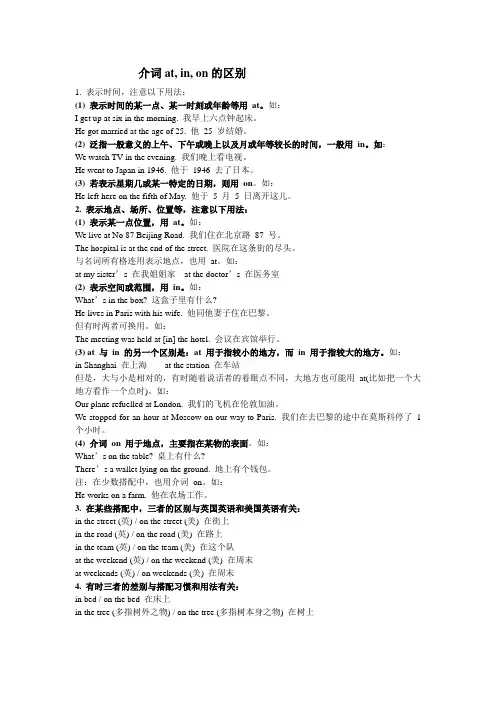
介词at, in, on的区别1. 表示时间,注意以下用法:(1) 表示时间的某一点、某一时刻或年龄等用at。
如:I get up at six in the morning. 我早上六点钟起床。
He got married at the age of 25. 他25 岁结婚。
(2) 泛指一般意义的上午、下午或晚上以及月或年等较长的时间,一般用in。
如:We watch TV in the evening. 我们晚上看电视。
He went to Japan in 1946. 他于1946 去了日本。
(3) 若表示星期几或某一特定的日期,则用on。
如:He left here on the fifth of May. 他于5 月5 日离开这儿。
2. 表示地点、场所、位置等,注意以下用法:(1) 表示某一点位置,用at。
如:We live at No 87 Beijing Road. 我们住在北京路87 号。
The hospital is at the end of the street. 医院在这条街的尽头。
与名词所有格连用表示地点,也用at。
如:at my sister’s 在我姐姐家at the doctor’s 在医务室(2) 表示空间或范围,用in。
如:What’s in the box? 这盒子里有什么?He lives in Paris with his wife. 他同他妻子住在巴黎。
但有时两者可换用。
如:The meeting was held at [in] the hotel. 会议在宾馆举行。
(3) at 与in 的另一个区别是:at 用于指较小的地方,而in 用于指较大的地方。
如:in Shanghai 在上海at the station 在车站但是,大与小是相对的,有时随着说话者的着眼点不同,大地方也可能用at(比如把一个大地方看作一个点时)。
如:Our plane refuelled at London. 我们的飞机在伦敦加油。
in,at,on的所有用法内容:on,at,in这三个常用介词都可以表示时间和地点,但具体用法不同,不少初学者对它们混淆不清。
现在请读、记下面两个口诀,只要记住了口诀,就可避免at,on,in的种种误用。
(1)口诀之一(on,in,at表时间)。
on“在具体某一天”①“当某时”,动名词前,arrival,death记心间②;early,late位句先,用in一般“上”“下”“晚”③④;at是个时间点,“工作”“时刻”与“圣诞”⑤。
注:①on表示在具体某一天及具体某一天的上午、下午和晚上。
例:On Children’s Day,all the boys and girls are wearing their newclothes.儿童节,所有的孩子们都穿上了新衣服。
②On my arrival home,I found he had gone already.当我到家时,我发现他已经走了。
③当early,late用于句首修饰介词短语时,尽管表示具体某一天的上午、下午、晚上,都要用in(如例句1),泛指一般的上、下午,晚上也用in(如例句2)。
例:1)Early in the morning of National Day,I got up to catch the firstbus to the zoo.国庆节一清早,我便起床去赶到动物园的第一班公共汽车。
2)My father begins work at 8:00 in the morning and stops workat 4:00 in the afternoon.我父亲上午8点上班,下午4点下班。
④用于将来时态表示“过一段时间后”(如例句1)及表示“在……期间”(如例句2)和“在某个季节,某年、某月”(如例句3)都用in。
请看如下例句:1)I hear he’ll be back in a month.我听说他将于一个月后回来。
2)In the course of the last lesson in French,little Franz was listen-ing to the master very attentively.在那最后一堂法语课中,小弗朗兹非常用心地听着老师讲。
介词in at on的用法总结介词in、at、on是英语中常用的介词,它们在句子中有着不同的用法和含义。
本文将对这三个介词的用法进行总结。
一、in的用法1. 表示时间:in用于表示某个时间段内,如in the morning(早上)、in the afternoon(下午)、in the evening(晚上)、in the summer (夏天)等。
2. 表示地点:in用于表示某个地点内,如in the room(房间内)、in the city(城市内)、in the park(公园内)等。
3. 表示状态:in用于表示某种状态,如in trouble(陷入困境)、in love(恋爱中)、in a hurry(匆忙)等。
4. 表示方式:in用于表示某种方式,如in English(用英语)、in writing(以书面形式)、in person(亲自)等。
二、at的用法1. 表示时间:at用于表示具体的时间点,如at 8 o'clock(8点钟)、at noon(中午)、at night(晚上)等。
2. 表示地点:at用于表示某个地点,如at home(在家)、at school (在学校)、at the airport(在机场)等。
3. 表示状态:at用于表示某种状态,如at ease(放松)、at risk (有风险)、at fault(有过错)等。
4. 表示动作:at用于表示某种动作,如at work(在工作)、at play (在玩耍)、at rest(在休息)等。
三、on的用法1. 表示时间:on用于表示某个具体的日期或星期几,如on Monday(星期一)、on July 1st(7月1日)、on Christmas Day(圣诞节)等。
2. 表示地点:on用于表示某个表面或平面上,如on the table(在桌子上)、on the wall(在墙上)、on the floor(在地板上)等。
精诚教育时间介词in, on与at的用法介词in, on与at都可用于表示时间的名词前,但用法各不相同,其区别在于:一、用in的场合(1)表示“在某年/月/季节”这个含义时,须用介词in。
例如:She came to this city in 1980.他于1980年来到这个城市。
It often rains here in summer.夏天这里常常下雨。
(2)表示“从现在起一段时间以后”时,须用介词in。
例如:They will go to see you in a week.他们将在一周后去看望你。
I will be back in a month.我将在一个月后回来。
(3)表示“在某世纪”时,须用介词in.例如:This machine was invented in the eighteenth century.这台机器是在18世纪发明的. Great changes took place in the twentieth century.20世纪发生了巨大变化.(4)表示“在某年代或特定世纪某年代”时,须用介词in。
例如:This incident happened in the 1970's.该事件发生在20世纪70年代。
The Anti-Japanese War broke out in the 1930''''s.抗日战争爆发于20世纪30年代。
(5)除此之外,morning / evening / afternoon 三个词也常跟介词in连用。
例如: Don't watch TV too much in the evening.晚上看电视不要太多。
They sometimes play games in the afternoon.他们有时在下午做游戏。
二、用on的场合(1)表示“在具体的某一天”或“(在具体的某一天的)早上、中午、晚上”等,须用介词on。
at in on的用法at, in, on的用法一、概述在英语中,介词是非常重要的一部分语法成分,它们用于表示名词与其他词或短语之间的关系。
这篇文章将重点介绍三个常见的介词:at、in和on,并详细讨论它们在句子中的具体用法。
二、at的用法1. 表示地点at常用来表示一个特定的地点,例如:- I will meet you at the park.我会在公园和你见面。
- She works at a restaurant.她在一家餐馆工作。
注意,当所指地点是机构、公司或建筑物时,通常使用at。
而对于城市、国家或岛屿等地名,则需要使用in。
2. 表示具体时间at也可用来表示一个具体的时间点,例如:- The meeting starts at 9 o'clock.会议从九点开始。
- I usually have lunch at noon.我通常在中午吃午饭。
不过,在表达某种时间段时,通常会使用in而不是at。
3. 表示活动at还可用来表示某些活动、事件或行为,例如:- They laughed at his joke.他们笑了他的笑话。
- Don't be surprised if people stare at you.如果有人盯着你看,请不要感到惊讶。
三、in的用法1. 表示地点in常用来表示一个较大的区域或地方,例如:- She lives in New York City.她住在纽约市。
- The book is in my bag.书在我的包里。
通常,当所指地点是某个特定的建筑物或机构时,应使用at。
2. 表示时间段in通常用于表示一段持续的时间,在以下情况下使用:- She will graduate in two years.她将在两年后毕业。
- I have a meeting in the afternoon.我下午有个会议。
但是,在表示具体的时间点时,应使用at而不是in。
in at on介词的用法一、介词in的用法1. 表示位置介词"in"可以用来描述某物或某人在一个地点的内部或范围之中。
例如:- The cat is in the box.(猫在盒子里)- The books are in the library.(书在图书馆里)2. 表示时间介词"in"也可用于表示某个时间段或特定的时刻。
例如:- We usually have a meeting in the morning.(我们通常在早上开会)- She was born in July.(她出生在七月)3. 表示状态或条件当涉及到某种状况或情况时,介词"in"可以使用。
例如:- He is in good health.(他身体很健康)- You are in trouble now.(你现在有麻烦了)4. 表示参与活动或工作领域介词"in"还可用来表达参与某项活动或从事某个领域的工作。
例如:- She is interested in playing tennis.(她对打网球感兴趣)- He works in the IT industry.(他从事IT行业)二、介词at的用法1.表示地点介词"at"经常被用来指明准确的位置。
例如:- I am waiting for you at the bus stop. (我正在公交车站等你)- Let's meet at the coffee shop. (我们在咖啡店见面)2.表示特定的时间介词"at"用于表示具体的时刻。
例如:- We have an appointment at 3 o'clock.(我们有一个3点钟的约会)- The concert starts at 7:30 PM.(音乐会晚上7:30开始)3.表示某种状态或情况有时候,介词"at"也可以用来描述某种状态或情况。
介词at,in与on的用法与区别介词at、in与on的用法与区别介词作为一种常见的词类,用于连接不同的词与词组,起到连接业务的作用。
英语中有很多介词,其中at、in与on是使用频率非常高的三个介词。
它们在使用中有一些相似之处,但也有一些不同之处。
本文将重点介绍at、in与on的用法与区别。
一、at的用法与区别1. 表示具体位置或地点at一般用于表示精确的位置或地点,强调在某个具体的地方。
比如:- She is waiting for you at the bus stop.(她正在公交车站等你。
)- The party will be held at his house.(聚会将在他家举行。
)2. 表示具体时间at也可用于表示具体的时间点。
比如:- We will meet at 10:00.(我们将在10点见面。
)- He usually has dinner at 7:30.(他通常在7点30分吃晚饭。
)3. 表示活动或事件at可以用于表示某个活动或事件。
比如:- I'm good at playing basketball.(我擅长打篮球。
)- She is laughing at the joke.(她正在笑这个笑话。
)二、in的用法与区别1. 表示位置或地点in通常用于表示一个相对较大的范围,比如国家、城市、街道等。
比如:- I live in China.(我住在中国。
)- The museum is in London.(博物馆在伦敦。
)2. 表示时间段in也可以表示一个具体的时间段。
比如:- He will arrive in an hour.(他将在一个小时后到达。
)- The project will be completed in two weeks.(这个项目将在两周内完成。
)3. 表示状态或条件in还可以用于表示某种状态或条件。
比如:- The flowers are in full bloom.(花开得很盛。
1)in 把地方、地点、位置当作一个范围或一个封闭的空间:
1. I live in Beijing. 我住在北京。
(大城市用in)
2. I live in England, at London. 我住在英国伦敦。
(England大过London喔)
3. I live in a big city, my brother lives at a small town. 我住在大城市,我
哥哥住在一个小市镇。
(如果把city看做一个圆圈,small town就成一个点。
因此就in
a city, at a small town. 呵呵)
4. We have a meeting in Beijing. 我们有北京有一个会议。
5. Mars is in the Solar System. 火星在太阳系里。
6. in a car 乘汽车(不是on a car 也不是by a car 喔)
7. in a taxi 乘的士(不是on a taxi 或by a taxi )
8. in a helicopter 乘直升机
9. in a boat 乘小船
10. in a lift (elevator) 乘电梯(电梯像个笼子,当然要用in 啦)
11. in the newspaper 在报上
12. in the sky 在空中
13. in the bed 在床上(也可用on the bed)
14. in the bedroom/ class/ library/ school 在寝室/课室/图书馆/学校
.
2).at 把地方、地点、位置当作一个“点”:
1. The begger is sitting at the corner. 那乞丐坐在角落里。
2. Jane is waiting for you at the bus stop. Jane在巴士站等你。
3. at home 在家
4. Who's standing there at the door? 谁站在门口?
5. at the top of the page 在一页的上面
6. The shop is at the end of the road. 那商店就在路的尾端。
7. at the entrance 在进口处
8. at the crossroads 在十字路口
9. When will you arrive at the office? 你什么时候会到公司呢?
10. I'm in France, at Paris. 我住在法国巴黎。
(相对法国来讲,巴黎只是一个
“点”)
11. There is a small hut at the foot of the hill. 山脚下有一座小屋子。
12. My aunt lives at 55 Boretz Road in Durham.
我的姑妈住在Durham,Boretz 路门牌55号。
(地址要用at,不能用in)
13. at the side 在一边
14. at reception 在招待会上
15. I'm at work. 我在工作。
16. at class/ home/ the library/ the office/ school 在班上/家里/图书馆/公
司/学校
(3). on 把地方、地点、位置当作一个平面:
1. The author's name is on the cover of the book. 在书的封面上有作者的名
字。
2. There are no prices on this menu. 在这菜单上没有价钱。
3. You are standing on my foot. 你踏到我的脚了。
4. There was a "no smoking" sign on the wall. 在那墙上有个“不准吸烟”的牌
子。
5. I live on the 7th floor at 21 Oxford Street in London. 我住在伦敦牛津街
21号八楼。
(7th floor 就是八楼;注意句中的on, at, in 的用法)
6. on a bus 乘巴士(不是in a bus 喔)
7. on a train 乘火车(可想像“骑”在火车上,哈哈)
8. on a plane 乘飞机(可想像“骑”在飞机上)
9. on a ship 乘轮船
10. on a bicycle, on a motorbike 骑自行车/摩托车
11. on a horse, on an elephant 骑马/象
12. on the radio, on television 听广播、看电视
13. on the left, on the right 在左边、在右边
14. on the way 在路上
15. on the bed 在床上(也可用in the bed)
16. on the ceiling 在天花板上
17. on the floor 在地板上
on,at,in用法巧记
on,at,in这三个常用介词都可以表示时间和地点,但具体用法不同,多数学生对它们混淆不清。
现在只要记住了口诀,就可避免at,on,in的种种误用。
1. on,in,at表示时间
on“在具体某一天”①
“当某时”,动名词,arrival,death前;early,late位句先②,用in一般“上”“下”“晚”;on 用于天,in用于月、季、年③;限定三时in要变。
④at是个时间点,“工作”“时刻”与“圣诞”⑤。
at noon(night),in the day,习惯用语记心间。
注:①on表示在具体某一天及具体某一天的上午、下午和晚上。
例On mother's Day, we should send flowers to our mother. 母亲节,我们应该送花给我们的母亲。
On my arrival home,I found he had gone already.当我到家时,我发现他已经走了。
②当early,late用于句首修饰介词短语时,尽管表示具体某一天的上午、下午、晚上,都要用in,泛指一般的上、下午,晚上也用in 。
例Early in the morning of National Day,I got up to catch the first bus to the zoo.国庆节一清
早,我便起床去赶到动物园的第一班公共汽车。
My father begins work at 8:00 in the morning and stops work at 4:00 in the afternoon.我父亲上午8点上班,下午4点下班。
③于将来时态表示“过一段时间后” 及表示“在……期间” 和“在某个季节,某年、某月” 都用in。
例I hear he’ll be back in a month.我听说他将于一个月后回来。
In the course of the last lesson in French,little Franz was listening to the master very attentively.在那最后一堂法语课中,小弗朗兹非常用心地听着老师讲。
Xiao Ming was born in December of 2004. 小明生于2004年12月。
④当morning,afternoon,evening有前位定语或后置定语限定时,就不用in而用on。
例on a hot (summer) noon 在一个炎热(夏天)的中午
on Monday morning 在星期一上午
on the morning of March 8th在3月8日上午
⑤表示某时某刻及在work,Christmas前用at。
例We get up at eight o’clock.我们8点起床。
My father are busily at work all day.我父亲整天忙于工作。
In western countries children get present from their parents at Christmas.在西方国家,孩子们在圣诞节得到父亲给的礼物。